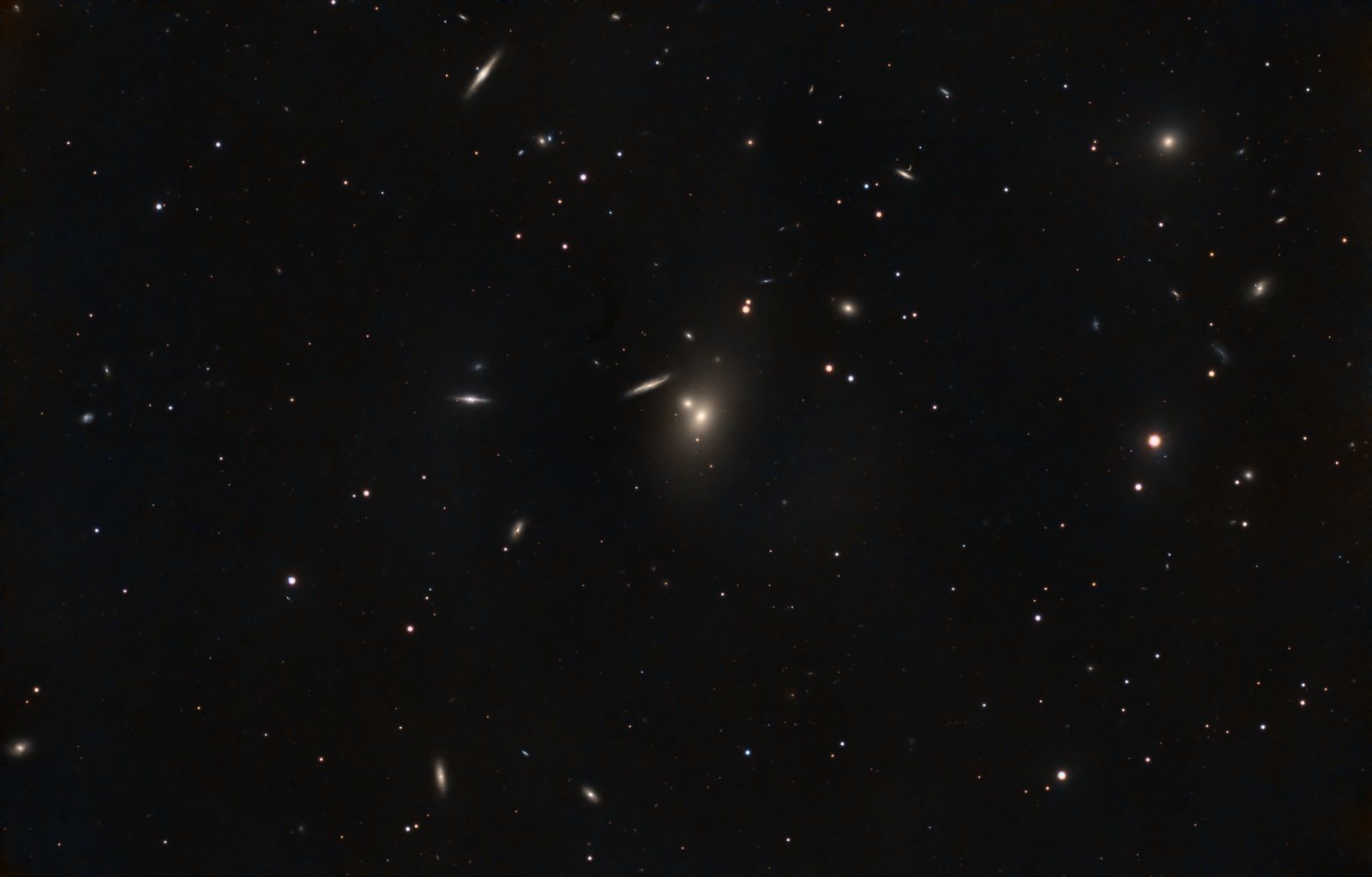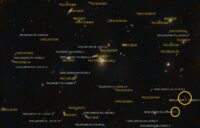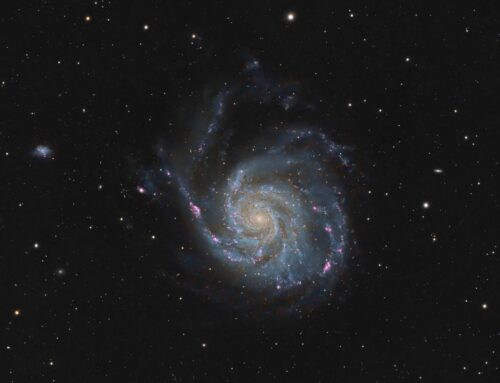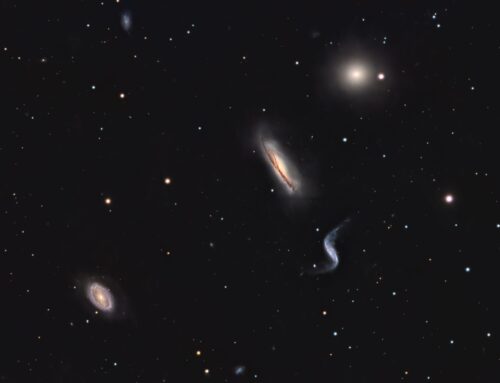Abell 779 Galaxy Cluster
Click image for full size version
February 11, 2024
Abell 779 is a cluster of galaxies in the constellation Lynx. It lies about 300 million light years away and contains dozens of galaxies. Abell 779 contains several prominent galaxies, like large elliptical NGC 2832 at centre, and edge-on spiral NGC 2830 a little to its upper left. You can find many others in the annotated image where they’re highlighted in yellow.
Much more interestingly, the white highlights in the annotated image identify quasars. Quasars (also known as “quasi-stellar objects”) are extremely distant and are a type of Active Galactic Nucleus (AGN). They shine incredibly brightly considering their great distance. The closest known quasar is 600 million light years away.
The distance to a far-away object can be determined from how much its light is shifted towards the red part of the spectrum (called the “red shift”). I looked up the red shift (published in the Million Quasars Project) for two quasars in the image (marked with yellow circles) and estimated their distances (see this calculator). The results were so astonishing that I verified them with a second online calculator.
Tekkies:
Acquisition, focusing, and control of Paramount MX mount with N.I.N.A. and TheSkyX, unguided. Primalucelab low-profile 2″ Essato focuser and ARCO rotator. Equipment control with PrimaLuce Labs Eagle 4 Pro computer. All pre-processing and processing in PixInsight. Acquired from my SkyShed in Guelph. Above average transparency and seeing. Data acquired February 5-6, 2024 in a moonless sky.
Celestron 14″ EDGE HD telescope at f/11 (3,912 mm focal length) and QHY600M camera binned 2×2 with Optolong filters.
59 x 1m Red = 59m
54 x 1m Green = 54m
55 x 1m Blue = 55m
Total: 2hr48m
Preprocessing: The WeightedBatchPreProcessing script was used to perform calibration, cosmetic correction, weighting, registration, local normalization, integration and drizzle integration (1x, 0.95 ddrop shrink, Gaussian) of all frames. The R, G and B channels were combined with ChannelCombination.
Gradient Removal: GraXpert was applied to the RGB master.
Star Correction: BlurXterminator was applied with Correct Only checked.
Colour Calibration: ColorCalibration was used to calibrate the RGB master.
Deconvolution: BlurXterminator was applied using an automatic PSF, and star sharpening set to 0.35.
Star Removal: StarXterminator was used to remove the stars, with Unscreen selected.
Linear Noise Reduction: NoiseXterminator was applied with Amount=0.95 and Detail=0.35
Stretching: HistogramTransformation was applied to make a pleasing yet bright image. Approximate background level after stretch was 0.10
Nonlinear Processing
Nonlinear Noise Reduction: NoiseXterminator was applied with Amount=0.9 and Detail=0.15
Supplemental Stretching: HistogramTransformation was used to adjust the black point and increase brightness and contrast. Approximate background level after stretch was 0.10
Contrast Enhancement: Using a mask to select the galaxies, LocalHistogramEqualization was applied twice. A Contrast Limit of 1.5 and 1 iteration was used for each LHE application (scale 50, strength 0.25; scale 150, strength 0.18).
Sharpening: The same mask was used with MultiscaleMedianTransform to sharpen Layers 1 – 4 with strengths of 0.01, 0.03, 0.03, and 0.01, respectively.
Stars-only steps: The stars-only image was stretched with HistogramTransformation. The stretch was slightly less aggressive than the sreen transfer function applied automatically by StarXterminator. CurvesTransformation CIE c* (colourfulness) slider was used to add colour saturation to the stars through a mask made by extracting the Luminance from the stretched stars-only image.
Star Restoration: PixelMath expression combine(starless, stars, op_screen()) was used to combine the starless and stars-only images created with StarXterminator.
Final Steps: Background, galaxy and star brightness, contrast and saturation were adjusted in several iterations using CurvesTransformation with masks as required. ICCProfileTransformation (sRGB IEC61966-2.1; Relative Colorimetric with black point compensation) was applied prior to saving as a jpg. The image was annotated with the AnnotateImage script. The finder chart was made using the FindingChart process.









Leave A Comment